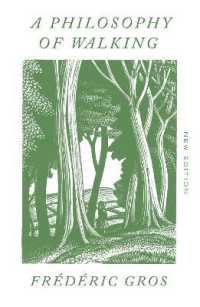- ホーム
- > 洋書
- > 英文書
- > Science / Mathematics
Full Description
Combining multiple sensors in order to better grasp a tricky, or even critical, situation is an innate human reflex. Indeed, humans became aware, very early on, of the need to combine several of our senses so as to acquire a better understanding of our surroundings when major issues are at stake. On the basis of this need, we have naturally sought to equip ourselves with various kinds of artificial sensors to enhance our perceptive faculties. The association of multiple heterogeneous sensors provides a reliable and efficient situation assessment in difficult operational contexts, but imperfect local observations need to be managed in a suitable way (uncertainty, imprecision, incompleteness, unreliability, etc.). The theories of uncertainty make it possible to benefit from such information, but the implementation of these theories requires specific developments to meet the needs of multisensor data fusion.
This book first discusses basic questions such as: Why and when is multiple sensor fusion necessary? How can the available measurements be characterized in such a case? What is the purpose and the specificity of information fusion processing in multiple sensor systems? Considering the different uncertainty formalisms (probability, fuzzy set theory, possibility theory, belief function theory), a set of coherent operators corresponding to the different steps of a complete fusion process is then developed, in order to meet the requirements identified in the first part of the book. Furthermore, the implementation of these operators is illustrated and discussed within the framework of generic applications.
Contents
INTRODUCTION ix
CHAPTER 1. MULTISENSOR DATA FUSION 1
1.1. Issues at stake 1
1.2. Problems 4
1.2.1. Interpretation and modeling of data 8
1.2.2. Reliability handling 10
1.2.3. Knowledge propagation 11
1.2.4. Matching of ambiguous data 12
1.2.5. Combination of sources14
1.2.6. Decision-making 16
1.3. Solutions 21
1.3.1. Panorama of useful theories 21
1.3.2. Process architectures 24
1.4. Position of multisensor data fusion 27
1.4.1. Peculiarities of the problem 27
1.4.2. Applications of multisensor data fusion 28
CHAPTER 2. REFERENCE FORMALISMS 31
2.1. Probabilities 31
2.2. Fuzzy sets 35
2.3. Possibility theory 39
2.4. Belief functions theory 43
2.4.1. Basic functions 44
2.4.2. A few particularly useful cases 47
2.4.3. Conditioning/deconditioning 49
2.4.4. Refinement/coarsening 50
CHAPTER 3. SET MANAGEMENT AND INFORMATION PROPAGATION 53
3.1. Fuzzy sets: propagation of imprecision 53
3.2. Probabilities and possibilities: the same approach to uncertainty 56
3.3. Belief functions: an overarching vision in terms of propagation 57
3.3.1. A generic operator: extension 58
3.3.2. Elaboration of a mass function with minimum specificity 61
3.3.3. Direct exploitation of the operator of extension 64
3.4. Example of application: updating of knowledge over time 66
CHAPTER 4. MANAGING THE RELIABILITY OF INFORMATION 71
4.1. Possibilistic view 72
4.2. Discounting of belief functions 73
4.3. Integrated processing of reliability 75
4.4. Management of domains of validity of the sources 77
4.5. Application to fusion of pixels from multispectral images 82
4.6. Formulation for problems of estimation 87
CHAPTER 5. COMBINATION OF SOURCES 91
5.1. Probabilities: a turnkey solution, Bayesian inference 92
5.2. Fuzzy sets: a grasp of axiomatics 94
5.3. Possibility theory: a simple approach to the basic principles 102
5.4. Theory of belief functions: conventional approaches 106
5.5. General approach to combination: any sets and logics 113
5.6. Conflict management 118
5.7. Back to Zadeh's paradox 122
CHAPTER 6. DATA MODELING 127
6.1. Characterization of signals 127
6.2. Probabilities: immediate taking into account 130
6.3. Belief functions: an open-ended and overarching framework 131
6.3.1. Integration of data into the fusion process 132
6.3.2. Generic problem: modeling of Cij values 135
6.3.3. Modeling measurements with stochastic learning 139
6.3.4. Modeling measurements with fuzzy learning 144
6.3.5. Overview of models for belief functions 148
6.4. Possibilities: a similar approach 153
6.5. Application to a didactic example of classification 157
CHAPTER 7. CLASSIFICATION: DECISION-MAKING AND EXPLOITATION OF THE DIVERSITY OF INFORMATION SOURCES 165
7.1. Decision-making: choice of the most likely hypothesis 166
7.2. Decision-making: determination of the most likely set of hypotheses 168
7.3. Behavior of the decision operator: some practical examples 171
7.4. Exploitation of the diversity of information sources: integration of binary comparisons 175
7.5. Exploitation of the diversity of information sources: classification on the basis of distinct but overlapping sets 179
7.6. Exploitation of the diversity of the attributes: example of application to the fusion of airborne image data 189
CHAPTER 8. SPATIAL DIMENSION: DATA ASSOCIATION 193
8.1. Data association: a multiform problem, which is unavoidable in multisensor data fusion 194
8.2. Construction of a general method for data association 197
8.3. Simple example of the implementation of the method 203
CHAPTER 9. TEMPORAL DIMENSION: TRACKING 211
9.1. Tracking: exploitation of the benefits of multisensory data fusion 211
9.2. Expression of the Bayesian filter 218
9.2.1. Statistical gating 218
9.2.2. Updating 219
9.2.3. Prediction 220
9.3. Signal discrimination process 221
9.3.1. Fusion at the level of each resolution cell 222
9.3.2. Fusion at the level of the validation gate 224
9.3.3. Overview of a practical implementation of the discrimination method 226
9.4. Extensions of the basic MSF 228
9.4.1. Data association 228
9.4.2. Joint tracking of multiple targets 229
9.4.3. Multi-model filtering 231
9.5. Examples of application 232
9.5.1. Extraction power 233
9.5.2. Handling of unfamiliar signatures 235
9.5.3. Tracking on spatially ambiguous observations 238
CONCLUSION 241
BIBLIOGRAPHY 249
INDEX 257








